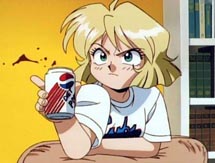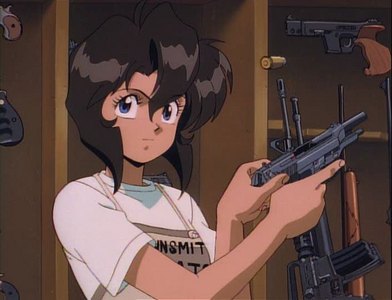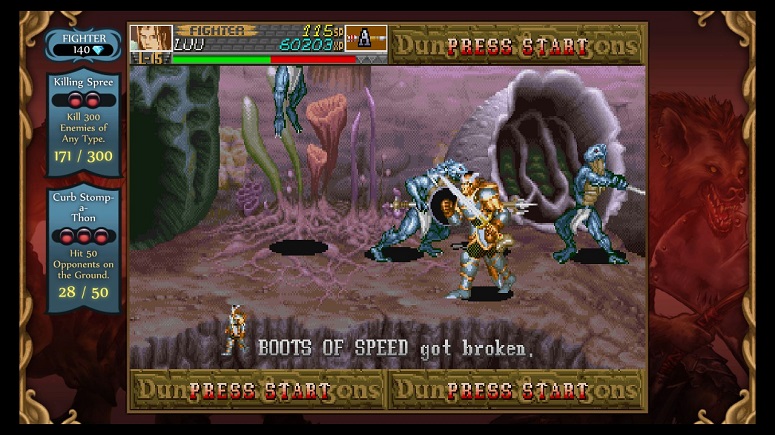 As anime became more and more popular in the West during the 90s, various companies went to great lengths working on bringing legions of shows to North America. By the end of that decade, those interested in the medium had an impressive selection of shows to choose from on DVD and VHS. Whether it was a full length series or a smaller, lesser known OVA, there was a lot to choose from.
As anime became more and more popular in the West during the 90s, various companies went to great lengths working on bringing legions of shows to North America. By the end of that decade, those interested in the medium had an impressive selection of shows to choose from on DVD and VHS. Whether it was a full length series or a smaller, lesser known OVA, there was a lot to choose from.
One such example of this was Gunsmith Cats, a three episode OVA based on Kenichi Sonoda’s manga of the same name. The show focused on a pair of women, Rally and May, who ran a gun shop in Chicago while also doing jobs on the side as part-time bounty hunters. It was a straightforward premise but more than adequate as a backdrop for adventure on the mean streets of the Windy City.
In the OVA, Rally and May are trying to stop a gun smuggling syndicate with connections to former Soviet military personnel, and who have ties to ambitious politicians in the upper echelons of government. It’s certainly a very paint-by-numbers story so far as 90s crime dramas go. Thanks to fun characters and plenty of action sequences, the whole thing is an enjoyable ride.
At the center of things are Rally and May. The former is a gun expert with amazing aim and encyclopedic knowledge of firearms. She has a good head on her shoulders and is the more levelheaded of the pair. Meanwhile, there is May who knows a ton about explosive. One would think that with the volatile substances that she uses, May would exercise a liberal amount of caution while on the job. That isn’t the case, though, as she’s all too eager to blow things up, getting the two into trouble from time to time. They’re a quirky pair that keep things more on the lighthearted side, only getting serious when infiltrating a gang hideout or something like that.
 The two are joined by a number of supporting characters like their friend Becky, who is also one of their main sources for information, as well as ATF agent Bill Collins who coerces Rally and May to help him with his investigation of the gun smuggling ring. There’s also the show’s main villain, Natasha Radinov.
The two are joined by a number of supporting characters like their friend Becky, who is also one of their main sources for information, as well as ATF agent Bill Collins who coerces Rally and May to help him with his investigation of the gun smuggling ring. There’s also the show’s main villain, Natasha Radinov.
We don’t spend a huge amount of time with these characters, so there isn’t really an opportunity for them to grow. Becky is just a sidekick who is sort of there helping out from time to time, while Radinov, albeit a badass, comes off as a one dimensional Russian villain. At least Bill does get fleshed out to some degree. He’s a bit of a loose cannon but after seeing how he operates for a while, it becomes obvious that he knows what he’s doing.
The show isn’t non-stop character development, though. Each episode ends with some sort of climactic action sequences, be it a gunfight, car chase, or something of that ilk. I’m particularly fond of the car chase in episode two, personally. There was a lot going on there with Rally chasing after Radinov while the two exchanged gunfire on the highway. It was quite exciting to watch their cars swerving around as bullets whizzed by. There’s something about the art here as well, that reminded me of Auto Modelista for some reason despite the fact that the game came out a decade after this OVA.
 With that, it’s worth noting that the art in Gunsmith Cats is very good. Given that it’s by Kenichi Sonoda, there’s a very distinctive style at play here. He was fairly popular in the 80s and 90s, so one could find his stuff pop up from time to time in anime, another good example being Gall Force in the mid-80s (a series I’m rather tempted to discuss some time in the future). There was a certain round, petite quality to many of his character designs, particularly women. It could get almost cutesy in a way that actually helped elevate comedic scenes. That isn’t to say that he did this across the board. Sonoda was plenty capable of making more traditional-looking characters as well, case in point being Bill Collins.
With that, it’s worth noting that the art in Gunsmith Cats is very good. Given that it’s by Kenichi Sonoda, there’s a very distinctive style at play here. He was fairly popular in the 80s and 90s, so one could find his stuff pop up from time to time in anime, another good example being Gall Force in the mid-80s (a series I’m rather tempted to discuss some time in the future). There was a certain round, petite quality to many of his character designs, particularly women. It could get almost cutesy in a way that actually helped elevate comedic scenes. That isn’t to say that he did this across the board. Sonoda was plenty capable of making more traditional-looking characters as well, case in point being Bill Collins.
Given that this is a show based on the works of Sonoda, however, it does mean that there is a fair bit of fan service. Most of it comes from the fact that Rally and May seem to like walking around their house in their underwear, but at least it’s presented in a logical manner and doesn’t feel forced as a mechanism to make up for a dull story. Moreover, it could have been a lot worse, as the manga shows a ton more skin and can get pretty darn explicit at times. (There’s certainly a market for that sort of thing, but it’s not my cup of tea.)
On the whole, the Gunsmith Cats OVA makes for an entertaining little action-y crime story. It gives us a glimpse into Rally and May’s world without being overwhelming. It’s able to tell its tale without feeling rushed, or leaving things out due to time constraints. These days, there are a lot of anime based on manga that run for a single season introducing viewers to its world, but end on a cliffhanger expecting people to just pick up the manga after. It feels incomplete and a little sleazy simply functioning as a tool to sell books in the end. They’d do well to follow Gunsmith Cats example, making a short, contained OVA story. It would still peak a lot of people’s curiosity while at the same time having its story come to a satisfying conclusion.
[Note: I do the Twitter thing, so if for some odd reason you want to read much shorter ramblings of mine, follow me there!]
 During high school, there were a couple of genres that I liked to spend a lot of time with: RPGs and beat ‘em ups. They’re certainly on opposite ends of the spectrum in terms of what they have players doing. One tends to be of a slower pace, building up character stats, and having a good think about how to defeat particularly tough enemies, all while exploring a big, mysterious world. The other is all about running around punching hordes of enemies in the face, often in co-op mode so friends can come and help.
During high school, there were a couple of genres that I liked to spend a lot of time with: RPGs and beat ‘em ups. They’re certainly on opposite ends of the spectrum in terms of what they have players doing. One tends to be of a slower pace, building up character stats, and having a good think about how to defeat particularly tough enemies, all while exploring a big, mysterious world. The other is all about running around punching hordes of enemies in the face, often in co-op mode so friends can come and help. Second, the game had the Dungeons and Dragons license, which opened the door to a number of possibilities. Most obviously, there was the attempt to implement some degree of RPG elements. Capcom did give this a try a couple of years earlier with King of Dragons and arguably to a lesser extent on Knights of the Round, although these were a rudimentary first kick of the can at meshing the two genres together. Characters leveled up and got new equipment as players got further into the games. It wasn’t huge, but did give a basic sense of progress and character growth.
Second, the game had the Dungeons and Dragons license, which opened the door to a number of possibilities. Most obviously, there was the attempt to implement some degree of RPG elements. Capcom did give this a try a couple of years earlier with King of Dragons and arguably to a lesser extent on Knights of the Round, although these were a rudimentary first kick of the can at meshing the two genres together. Characters leveled up and got new equipment as players got further into the games. It wasn’t huge, but did give a basic sense of progress and character growth. Characters only had six inventory slots, though, so they did have to make choices as to what they wanted to carry with them. It wasn’t possible to horde everything that they stumbled across. This was done by item type, however, so item stacking was possible. It was just a question of whether it was more beneficial to continue on with six daggers or a ring of magic missile, for example. Given that all of the game’s characters were armed with swords, maces, and the like, these items were limited to projectile weapons, as it would have been silly to give a dwarf a plank with a nail it it when he already had a perfectly good axe.
Characters only had six inventory slots, though, so they did have to make choices as to what they wanted to carry with them. It wasn’t possible to horde everything that they stumbled across. This was done by item type, however, so item stacking was possible. It was just a question of whether it was more beneficial to continue on with six daggers or a ring of magic missile, for example. Given that all of the game’s characters were armed with swords, maces, and the like, these items were limited to projectile weapons, as it would have been silly to give a dwarf a plank with a nail it it when he already had a perfectly good axe. Greedy priests aside, multiplayer was one of the best things about Tower of Doom. The game supported up to four players at once and, coincidentally enough, featured four different characters to play as. There was a dwarf, a priest, a warrior, and an elf. They didn’t have names, but filled the main archetypal roles in an RPG. The characters look quite nice with a noticeable anime-like flair to them. I’ve always been fond of the elf in no small part thanks to her resemblance to Deedlit from Record of Lodoss War.
Greedy priests aside, multiplayer was one of the best things about Tower of Doom. The game supported up to four players at once and, coincidentally enough, featured four different characters to play as. There was a dwarf, a priest, a warrior, and an elf. They didn’t have names, but filled the main archetypal roles in an RPG. The characters look quite nice with a noticeable anime-like flair to them. I’ve always been fond of the elf in no small part thanks to her resemblance to Deedlit from Record of Lodoss War. Making its story all the more interesting, and adding an element of replay value at the same time, was that at the end of each level players were presented with a choice as to what they should do next. It wasn’t a huge choice, being limited to two options, but it was more than most other games offered outside of one racing Ferraris across America or waging intergalactic war against vast armadas of mechanical sea life. Even if players beat Tower of Doom, they could still come back to the game and try going down a different path for their next play through.
Making its story all the more interesting, and adding an element of replay value at the same time, was that at the end of each level players were presented with a choice as to what they should do next. It wasn’t a huge choice, being limited to two options, but it was more than most other games offered outside of one racing Ferraris across America or waging intergalactic war against vast armadas of mechanical sea life. Even if players beat Tower of Doom, they could still come back to the game and try going down a different path for their next play through. Eventually, both games even got ported to the Sega Saturn. Unfortunately, it was only released in Japan. So, anyone who really wanted to play either of those had to import them. As the years passed, the games’ price climbed and climbed making it prohibitively expensive for a lot of folks to get. A couple of years ago, though, Capcom inexplicably re-released both of them digitally for consoles and PC putting smiles on many people’s faces.
Eventually, both games even got ported to the Sega Saturn. Unfortunately, it was only released in Japan. So, anyone who really wanted to play either of those had to import them. As the years passed, the games’ price climbed and climbed making it prohibitively expensive for a lot of folks to get. A couple of years ago, though, Capcom inexplicably re-released both of them digitally for consoles and PC putting smiles on many people’s faces.